Introduction
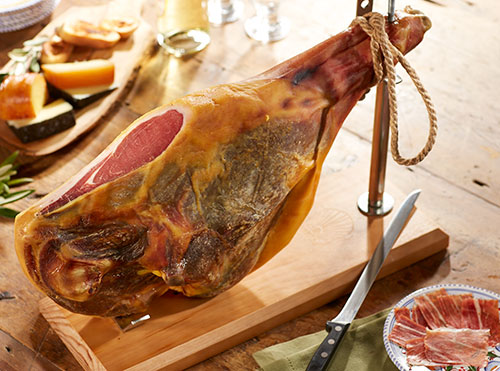
In the world of Spanish cured meats, Serrano and Iberico ham are two renowned delicacies that showcase the rich culinary heritage of Spain. These mouthwatering hams have been enjoyed for centuries, captivating the palates of food enthusiasts around the globe. While both Serrano and Iberico hams share similarities in their production process and cultural significance, they also exhibit distinct characteristics that set them apart. From the breed of pigs used to the taste, texture, and aroma, each type of ham offers a unique gastronomic experience. Join us as we delve into the world of Serrano vs Iberico hams and uncover the secrets behind these Spanish culinary treasures.
Overview Of Spanish Cured Meats
Spanish cured meats are renowned around the world for their exquisite flavor and unique production process. These meats are typically made from pork, which is carefully cured and aged to develop its distinct taste and texture. Popular Spanish cured meats include Serrano ham, Iberico ham, Chorizo, and Salchichón. Each of these meats showcases the rich culinary heritage of Spain and offers a range of flavors and textures. Spaniards have been perfecting the art of curing meats for centuries, resulting in a wide variety of delicious options for meat lovers to enjoy.
Distinguishing Characteristics Of Serrano And Iberico Meats
Serrano and Iberico meats have distinct characteristics that set them apart. One of the key differences is the breed of pig used. Serrano ham is typically made from white pigs, while Iberico ham comes from the renowned Iberian breed. This difference in breed contributes to variations in flavor, texture, and color. Serrano ham tends to have a milder taste with a lighter pink color, while Iberico ham boasts a richer, nuttier flavor and a deep ruby-red hue. The unique genetics and diet of Iberian pigs result in a more complex and flavorful meat. These distinguishing features make Serrano and Iberico meats a delight for any meat connoisseur.
Serrano Ham

Serrano ham is a traditional Spanish cured meat that is renowned for its exquisite flavor and delicate texture. It is made from the meat of white pigs, which are commonly found in Spain. Serrano ham is produced using traditional methods that have been passed down through generations. The meat is carefully cured and aged to develop its distinct taste. With its mild, slightly salty flavor and tender texture, Serrano ham is a versatile ingredient that can be enjoyed on its own or used to enhance various dishes. Its versatility and rich history make Serrano ham a beloved delicacy in Spanish cuisine.
History And Traditional Production Methods
Serrano ham has a rich history dating back centuries. The tradition of curing and preserving meat in Spain can be traced back to the Roman Empire. Over time, the techniques and methods of producing Serrano ham have been refined and perfected. The process begins with carefully selected white pigs, which are raised in specific regions of Spain known for their favorable climate and high-quality pastures. The meat is then salted and left to dry in cool, mountainous regions for extended periods. This slow and meticulous curing process allows the flavors to develop and intensify, resulting in the exquisite taste and texture that Serrano ham is known for.
Taste Profile And Culinary Uses
Serrano ham is known for its delicate and savory flavor, with hints of nuttiness and sweetness. It has a firm yet tender texture that melts in the mouth. This makes it perfect for eating on its own as a tapa or as an ingredient in various dishes. Serrano ham is a versatile ingredient that can be used in sandwiches, salads, pasta dishes, and even desserts. Its salty and umami-rich taste adds depth and complexity to any recipe. Whether sliced thinly for a charcuterie board or added to a hearty stew, Serrano ham is a culinary delight that enhances the flavors of any dish.
Iberico Ham
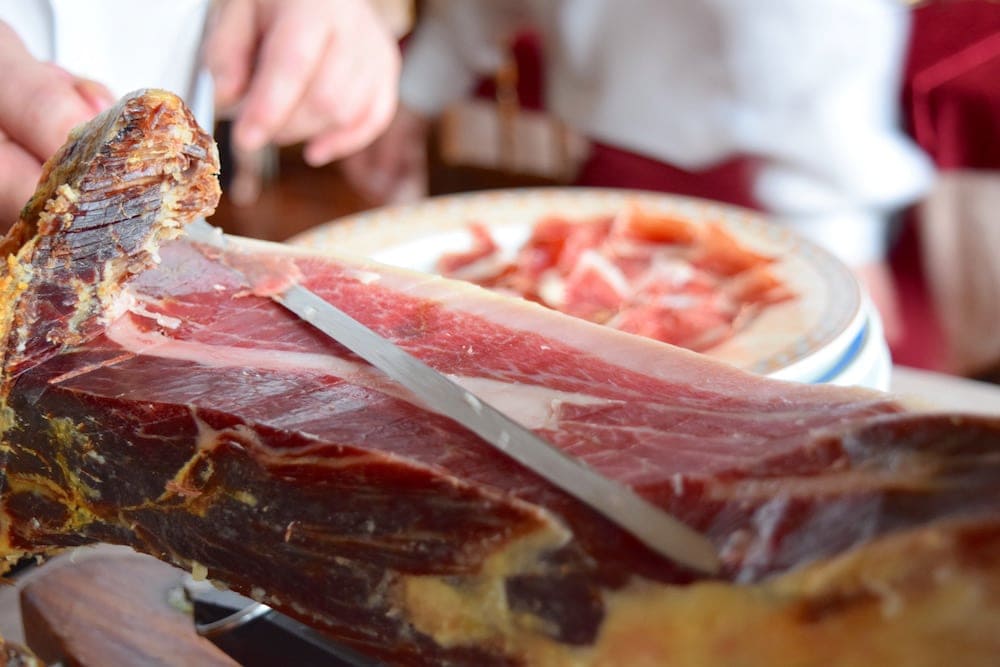
Background and unique qualities of Iberico pigs
Iberico ham, also known as Jamón Ibérico, is a highly prized Spanish cured meat made from the black Iberian pig. These pigs are native to the Iberian Peninsula and are known for their distinct genetics and diet. The Iberian pig is a rare and special breed, known for its ability to accumulate intramuscular fat, which gives the ham its rich and intense flavor.
The unique qualities of Iberico ham can be attributed to the pigs’ diet, which consists mainly of acorns during the fattening period, known as the montanera. This diet adds a nutty and slightly sweet flavor to the meat, creating a complex and indulgent taste profile.
Different grades and variations of Iberico ham
Iberico ham is categorized into different grades based on the diet and purity of the pigs. The highest grade is Jamón Ibérico de Bellota, which is made from purebred Iberian pigs that have freely roamed oak forests and fed on acorns during the montanera. This results in a ham with a deep, marbled texture and an exquisite and delicate flavor.
Other grades include Jamón Ibérico de Cebo de Campo, which is made from pigs that have been fed a combination of acorns and natural pastures, and Jamón Ibérico de Cebo, which comes from pigs raised on a controlled diet of grains and legumes.
Iberico ham is often noted for its intense aroma, smooth texture, and complex flavors that range from sweet and fruity to earthy and savory. It is best enjoyed sliced thinly and savored on its own or served with crusty bread and a glass of red wine.
Pairing and Serving Suggestions
When it comes to pairing Iberico ham, the richness and depth of flavors complement a variety of ingredients. It pairs wonderfully with aged cheeses, such as Manchego or Mahon, which enhance the nutty notes of the ham. For a refreshing contrast, serve it with slices of fresh melon or figs.
As for serving suggestions, Iberico ham is a staple in Spanish tapas and can be used to elevate a range of dishes. Wrap it around griddled asparagus or shrimp, toss it into pasta dishes, or use it as a topping for pizzas and flatbreads. Its versatility and unique flavor profile make it a beloved ingredient in both traditional Spanish cuisine and modern culinary creations.
In conclusion, Iberico ham is a culinary gem that showcases the unique qualities of the Iberian pig. Its exquisite taste, influenced by the pigs’ diet of acorns, makes it a remarkable delicacy. Whether enjoyed on its own or incorporated into dishes, Iberico ham is sure to impress with its rich flavor, smooth texture, and unparalleled gastronomic experience.
Background And Unique Qualities Of Iberico Pigs
Iberico pigs, also known as Pata Negra or Black Iberian pigs, are native to the Iberian Peninsula in Spain and Portugal. These pigs have a long and storied history, dating back thousands of years to prehistoric times. They have adapted to the rugged terrain and climate of the region, developing unique genetic qualities that set them apart from other pig breeds. The most notable characteristic of Iberico pigs is their ability to accumulate intramuscular fat, also known as marbling. This marbling gives the meat its signature rich and intense flavor, making Iberico ham a highly sought-after delicacy. Additionally, Iberico pigs are known for their long, slender legs and dark skin, which is why they are often referred to as Pata Negra, meaning “black hoof”. The pigs’ diet also contributes to the unique qualities of Iberico ham. During the fattening period, known as the montanera, Iberico pigs freely roam oak forests and feast on a diet primarily of acorns. This diet adds a distinct nutty and slightly sweet flavor to the meat, giving Iberico ham its complex and indulgent taste profile. The combination of genetics, diet, and climate make the Iberico pig a truly exceptional breed that produces some of the world’s finest cured meats.
Different Grades And Variations Of Iberico Ham
Iberico ham comes in various grades and variations, each offering a unique experience for discerning palates. The highest grade is the “Jamón Ibérico de Bellota,” made from pigs that roam freely in oak forests and feed on a diet primarily composed of acorns. This results in a rich and nutty flavor profile. The next grade is “Jamón Ibérico de Cebo de Campo,” where the pigs are also free-range but receive a diet supplemented with grains and natural pastures. Lastly, there is the “Jamón Ibérico de Cebo,” made from pigs raised on a diet of grains and allowed to roam in a limited space. These variations offer different depths of flavor and textures, allowing individuals to choose according to their personal preferences.
Serrano Vs. Iberico: A Comparison
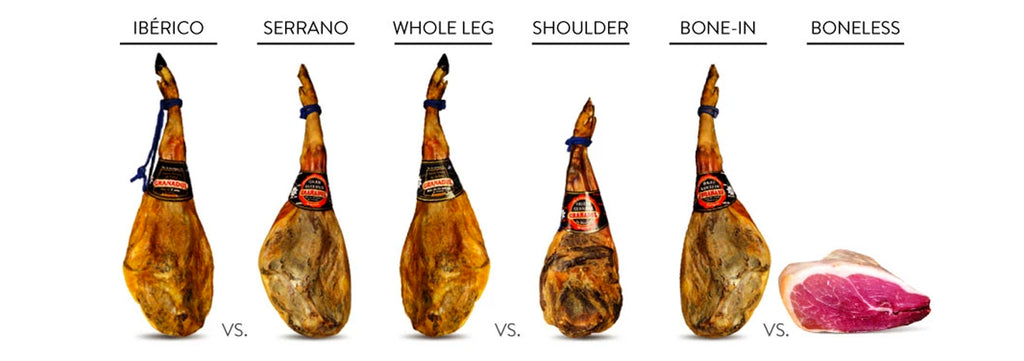
When comparing Serrano and Iberico ham, there are some key differences to consider. Serrano ham is made from a more common white pig breed, while Iberico ham is crafted exclusively from the rare and prized black Iberian pig. The pigs’ diet also plays a significant role in the flavor of the meat. Serrano ham is typically made from pigs raised on a grain-based diet, while Iberico ham comes from pigs that feast on acorns in oak forests. These variations result in distinct tastes, textures, and aromas that can be enjoyed by discerning meat enthusiasts.
Variations In Taste, Texture, And Aroma
When comparing Serrano and Iberico ham, the variations in taste, texture, and aroma are quite distinct. Serrano ham, with its saltier flavor, has a leaner texture and a milder aroma. On the other hand, Iberico ham offers a more complex and intense taste, thanks to the acorn-based diet of the Iberian pigs. Its marbled meat provides a rich and buttery texture, while the aroma showcases hints of nuts and the earthiness of the oak forests. These differences in flavor and sensory experience make each type of ham a unique gastronomic adventure.
Cultural Significance And Regional Differences
Cured meats have a rich cultural significance in Spain, where they are considered a culinary art form. Both Serrano and Iberico ham are deeply rooted in Spanish gastronomy. Serrano ham holds a special place in the cuisine of the central and southern regions of Spain, such as Castilla-La Mancha and Andalusia. It is commonly enjoyed in tapas, sandwiches, and traditional dishes.
On the other hand, Iberico ham is often associated with the southwestern region of Extremadura and the southern region of Andalusia. It has a long-standing tradition and is highly regarded as a delicacy. Iberico ham is often served on its own, thinly sliced and savored for its exquisite flavor and melt-in-your-mouth texture.
These regional differences reflect the diverse culinary traditions and preferences across Spain. Whether it’s the more widely available Serrano ham or the prized Iberico ham, both meats represent the rich cultural heritage and culinary excellence of Spanish cuisine.
Pairing And Serving Suggestions
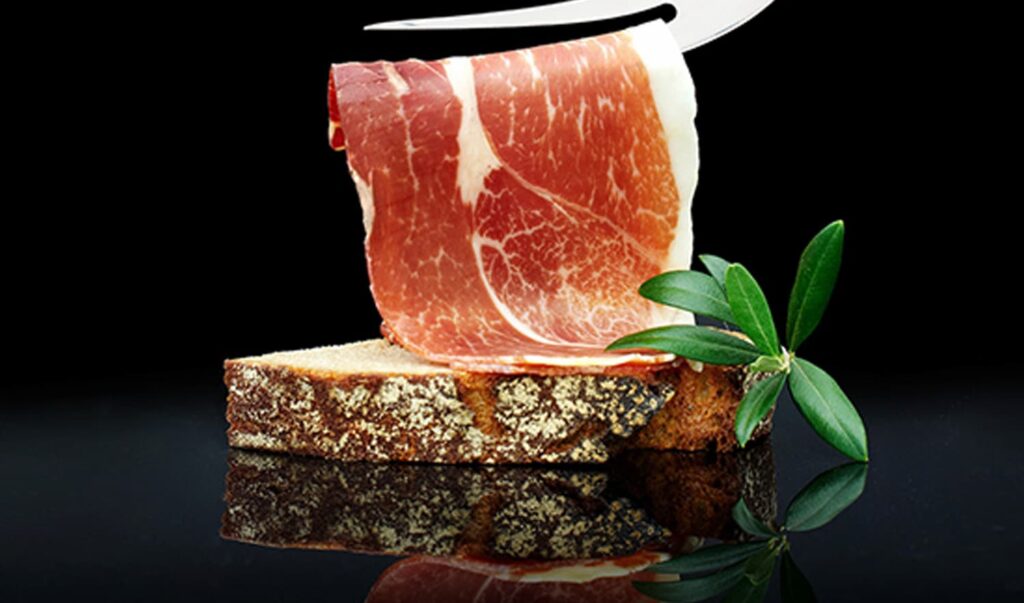
When it comes to pairing and serving Serrano and Iberico ham, there are a few key considerations to enhance your culinary experience.
For wine and cheese pairings, Serrano ham pairs well with medium-bodied red wines, such as Tempranillo or Rioja, as well as dry white wines like Verdejo or Albariño. Aged Manchego or Mahón cheese complements the flavors of Serrano ham perfectly.
When serving Iberico ham, opt for a full-bodied red wine like Ribera del Duero or Priorat to match the richness of the meat. Pair it with creamy and nutty cheeses like Idiazabal or a sharp blue cheese for a delightful contrast of flavors.
As for creative serving ideas, you can serve thinly sliced Serrano or Iberico ham on a platter with olives, crusty bread, and a drizzle of extra virgin olive oil. It also adds a delicious touch to salads, pasta dishes, or as a topping for grilled vegetables.
Lastly, for those who enjoy cooking, there are countless recipes that highlight the flavors of both Serrano and Iberico ham. From classic dishes like paella or potato tortilla to more inventive creations like stuffed mushrooms or ham-wrapped asparagus, the possibilities are endless.
Remember, whether you choose Serrano or Iberico ham, the key is to savor each bite and appreciate the distinct flavors of these Spanish delicacies. So, gather your loved ones, uncork a bottle of wine, and indulge in the rich and flavorful world of Spanish cured meats.
Wine And Cheese Pairings With Serrano And Iberico
When it comes to enhancing the flavors of Serrano and Iberico ham, wine and cheese make the perfect companions. For Serrano ham, opt for medium-bodied red wines like Tempranillo or Rioja, known for their fruity notes and balanced acidity. Dry white wines such as Verdejo or Albariño also pair well with Serrano ham, offering a refreshing contrast. To complete the experience, serve Serrano ham with aged Manchego or Mahón cheese for a delightful combination of flavors. When it comes to Iberico ham, the richness of the meat calls for full-bodied red wines like Ribera del Duero or Priorat. Rich, creamy cheeses like Idiazabal or sharp blue cheese make an excellent pairing, offering a contrast in texture and taste. Whether you’re enjoying Serrano or Iberico ham, the key is to find the perfect balance of flavors to truly savor each bite.
Creative Serving Ideas And Recipes
Get inspired by these creative serving ideas and recipes to elevate your Serrano and Iberico ham experience. For a visually appealing presentation, try wrapping thin slices of the ham around sweet melon chunks or juicy figs. Another popular option is to serve the ham on toasted bread with a drizzle of olive oil and a sprinkle of sea salt. For a more substantial dish, create a charcuterie board with a selection of cured meats, cheeses, olives, and crackers. And if you’re looking to add a unique twist, try incorporating the ham into dishes like pasta carbonara or Spanish-style omelettes. The possibilities are endless, so let your culinary creativity shine and enjoy the delicious flavors of Serrano and Iberico ham.
Conclusion
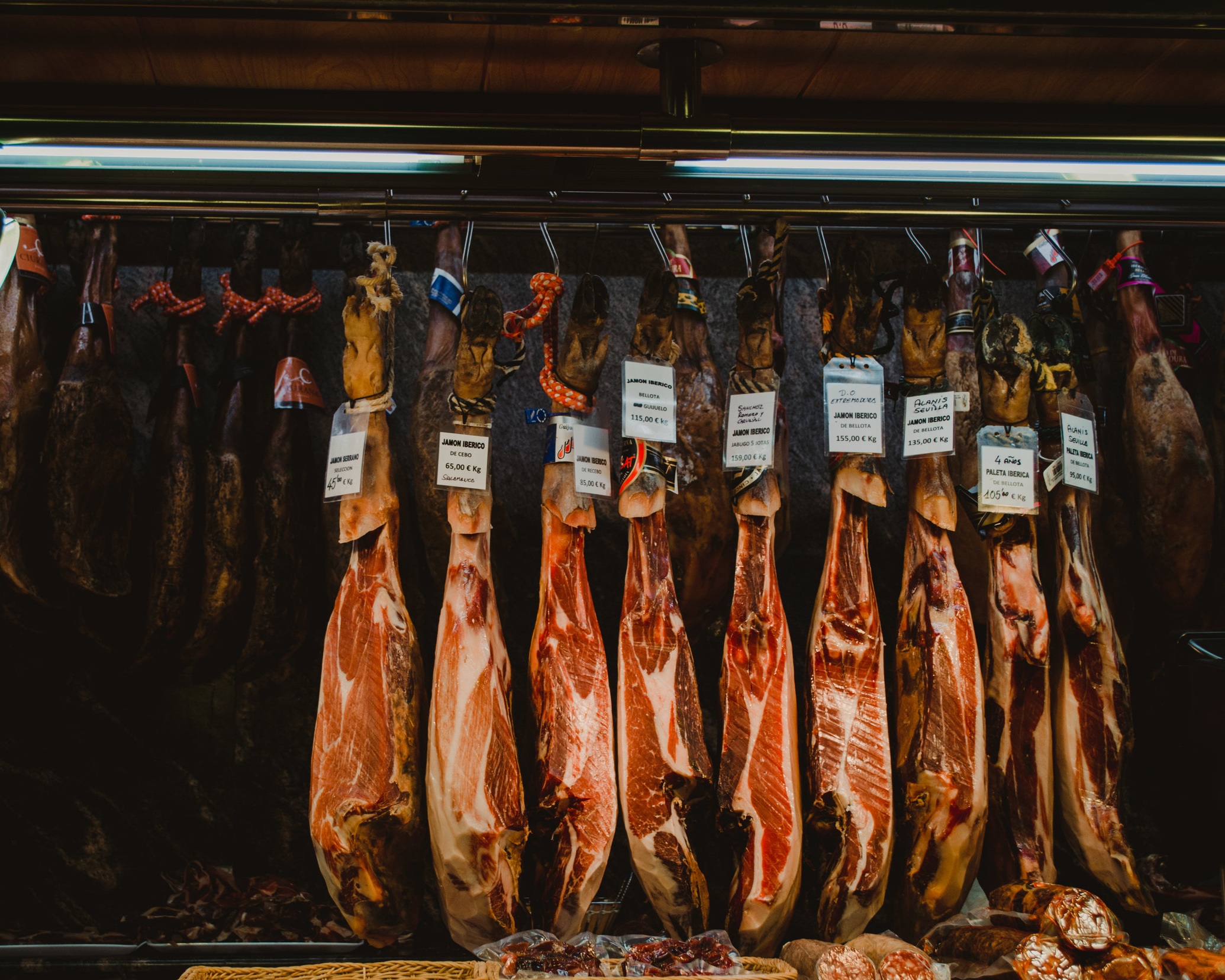
In conclusion, both Serrano and Iberico ham offer unique and delicious experiences for those seeking to explore Spanish cured meats. The Serrano ham, with its traditional production methods and versatile culinary uses, is a staple in Spanish cuisine. On the other hand, the Iberico ham, derived from the exceptional Iberian pig breed, boasts unparalleled flavors and textures. Whether you prefer the bold and robust flavors of Serrano or the complex and rich flavors of Iberico, these cured meats are sure to elevate any dish or charcuterie board. So, indulge in the flavors of Spain and savor the exquisite taste of Serrano and Iberico ham.
Health Benefits And Nutritional Value Of Spanish Cured Meats
Spanish cured meats, such as Serrano and Iberico ham, not only tantalize the taste buds but also offer several health benefits. These meats are a rich source of high-quality protein, essential vitamins, and minerals. They are low in saturated fats and cholesterol, making them a healthier choice compared to other processed meats. Additionally, Spanish cured meats contain antioxidants, such as vitamin E, which help protect cells from damage caused by free radicals. Incorporating these meats into a balanced diet can contribute to improved heart health, increased muscle growth, and enhanced overall well-being. So, indulge in the flavors of Spain while reaping the nutritional benefits of these delectable cured meats.
Tips For Purchasing And Storing Serrano And Iberico Ham
When purchasing Serrano and Iberico ham, it is important to look for quality and authenticity. Here are some tips to help you make the best choice:
- Source: Look for hams that come from reputable producers in Spain, as they follow traditional curing methods.
- Labeling: Check for specific labels such as “Jamon de Teruel” or “Jamon Iberico de Bellota” to ensure the authenticity and quality of the ham.
- Appearance: Inspect the ham for a deep red color, with white fat marbling and a firm texture.
- Aroma: The ham should have a pleasant, distinct aroma that is characteristic of cured meats.
When it comes to storing Serrano and Iberico ham, follow these guidelines:
- Temperature: Store the ham in a cool, dry place with a temperature between 50-60°F (10-15°C).
- Hanging: Hang the ham in a well-ventilated area, preferably with a ham holder. This allows the ham to breathe and prevents mold growth.
- Protection: Cover the cut surface of the ham with a cloth or muslin to prevent it from drying out.
With these tips, you can enjoy the delicious flavors of Serrano and Iberico ham while ensuring its quality and freshness.
FAQ About Serrano Vs Iberico: Exploring Spanish Cured Meats
Q: What is the main difference between Serrano and Iberico ham?
A: The main difference lies in the type of pigs used and the curing process. Serrano ham comes from white pigs and is usually cured for around 12-18 months, while Iberico ham comes from black Iberian pigs and is cured for a longer period, often up to 36 months.
Q: How does the flavor of Serrano ham differ from Iberico ham?
A: Serrano ham has a milder, slightly salty flavor compared to Iberico ham, which is richer, nuttier, and has a more intense, complex taste due to the pigs’ acorn-rich diet.
Q: Which one is more expensive, Serrano or Iberico ham?
A: Generally, Iberico ham is more expensive than Serrano ham due to the unique breed of pigs used, their acorn-fed diet, and the longer curing time required, making it a premium product.
Q: Can Serrano and Iberico ham be used interchangeably in recipes?
A: While both hams can be used in similar dishes, their flavor profiles differ significantly. Iberico ham’s distinct taste is best enjoyed on its own or paired with simple ingredients to fully appreciate its flavor, while Serrano ham can be a more versatile option for various recipes.
Q: Are there any specific serving recommendations for Serrano and Iberico ham?
A: Serrano ham is commonly served in thin slices as part of a charcuterie board or tapas, while Iberico ham is often enjoyed on its own to savor its unique taste. Pairing both types of ham with complementary foods like cheese, olives, or bread can enhance the overall experience.
Q: How should Serrano and Iberico ham be stored to maintain freshness?
A: Both hams should be stored in a cool, dry place away from direct sunlight. To preserve their flavor and texture, wrap them in a cloth or paper and store them in a breathable ham bag or a ham stand. It’s important to consume them within a reasonable time frame once opened to prevent them from drying out.

ToroGrill Canada is excited to share our one-of-a-kind and authentic South American BBQ flavors with the wonderful people of Canada. Our journey began with a passion for bringing South America’s rich and vibrant culinary traditions to a new audience, and we have been dedicated to this mission ever since. Our story is one of inspiration, hard work, and the pursuit of excellence. Every recipe, every ingredient, and every cooking technique has been carefully honed and perfected to ensure that when you take a bite of our food, you experience the true essence of South American BBQ.